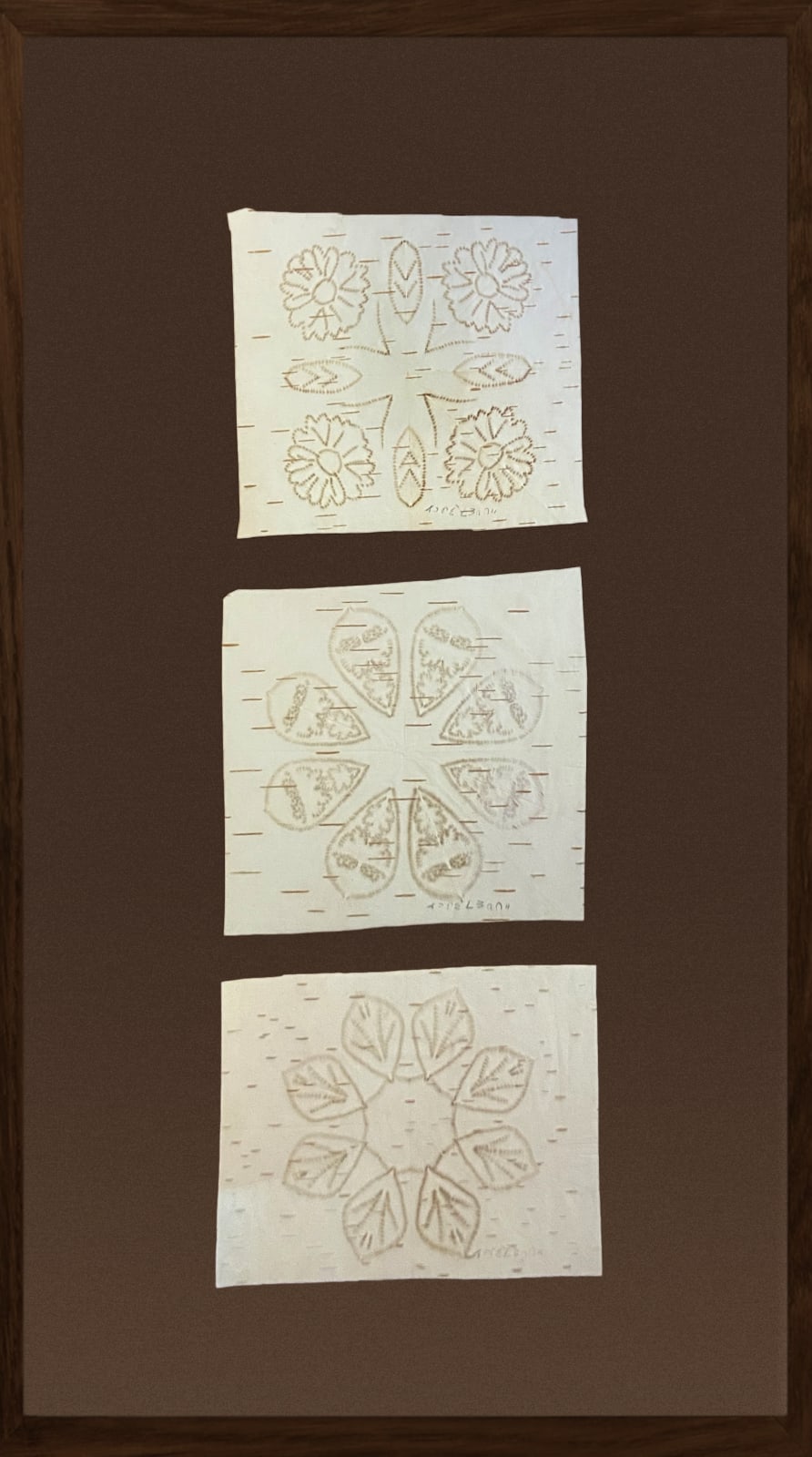-
Artworks
ANGELIQUE MERASTY (1924-1996) CREE
Three Birch Bark Bitingsthe first: with a central cruciform design, flanked by flowers and leaves;
the second: repeating decorated petals;
the third: repeating leaf motif connected to a central sixteen-sided polygon.
each incised birch bark, the first: 4.5 x 5 in (11.4 x 12.7 cm) / the second: 4.75 x 5 in (12.1 x 12.7 cm) / the third: 4 x 5.5 in (10.2 x 14 cm), contained within a single frame.
each signed, "ᐊᐣᒋᓬᐟᒪ ᕒᐢᑎᐦ.
LOT 86
ESTIMATE: $300 — $400Further images
Provenance
Private Collection, Montreal;
Estate of the above.The present works were created by Angelique Merasty using the traditional technique of birch bark biting wherein very thin, peeled inner layers of birch bark were folded and bitten using the incisors.
The origins of the birch bark bitings or transparencies are unclear. There is speculation they were done for recreational purposes and to provide a medium of design experimentation for patterns for beadwork and quill patterns [1].
In the 1983 catalogue for the travelling exhibition, Wigwas: Bark Biting by Angelique Merasty, curator Elizabeth McLuhan wrote, "Any acknowledgment for WIGWAS must begin and end with the artist herself, Angelique Merasty." [2]. McLuhan continued, "Bark biting is an ephemeral and subtle art involving four of the five senses in the creation of a final product that is as delicate and as fleeting as a butterfly wing" [3].
Her early bitings are symmetrical and geometric but Merasty soon developed a personal style and explored the possibilities that the medium and art form offered and there was a metamorphosis into works similar to the present that features a dazzling cast of insects and flowers. In the present lots, we see a splendid display of intricate bilaterally symmetrical styled patterns. That they were conceived of in her mind's eye and realized without the aid of her vision to ensure the patterns were cohesive makes them all the more impressive.
Merasty learned the technique of wigwas or birch bark biting from her mother, Susan Ballantyne, and was one of the last practitioners of this art. [2] [3]. Before her death in 1996, however, Angelique Merasty taught the technique to the Manitoba artist Angelique Merasty Levac (no relation) who continues to work in this tradition [4] [5].
1. Mary Zoccle, Wigwas: Bark Biting by Angelique Merasty, (Thunder Bay, ON: Thunder Bay Art Gallery, 1983), unpaginated.
2. Elizabeth McLuhan, "Acknowledgements", Wigwas: Bark Biting by Angelique Merasty, (Thunder Bay, ON: Thunder Bay Art Gallery, 1983), unpaginated.
3. "Wigwas: Bark Biting by Angelique Merasty", 1983, unpaginated.
4. Bernhard Cinader, The Birch Bark Sings, (Toronto: Ontario Place, Ontario North Galleries, 1986), p. 8
5. Barbara A. Hail, Out of the North : the subarctic collection of the Haffenreffer Museum of Anthropology, (Providence, RI: Haffenreffer Museum of Anthropology, Brown University, 1989), p. 285
4. Canadian Women Artists History Initiative, "MERASTY, Angelique", https://cwahi.concordia.ca/sources/artists/displayArtist.php?ID_artist=5391, accessed 2 September 2020.
5. To see works by Angelique Merasty Levac and comments on her tutelage, see "Honouring Tradition: Reframing native Art, exh. cat., (Calgary, AB: Glenbow, 2008), p. 100
2of 2
Join our mailing list
* denotes required fields
We will process the personal data you have supplied in accordance with our privacy policy (available on request). You can unsubscribe or change your preferences at any time by clicking the link in our emails.










